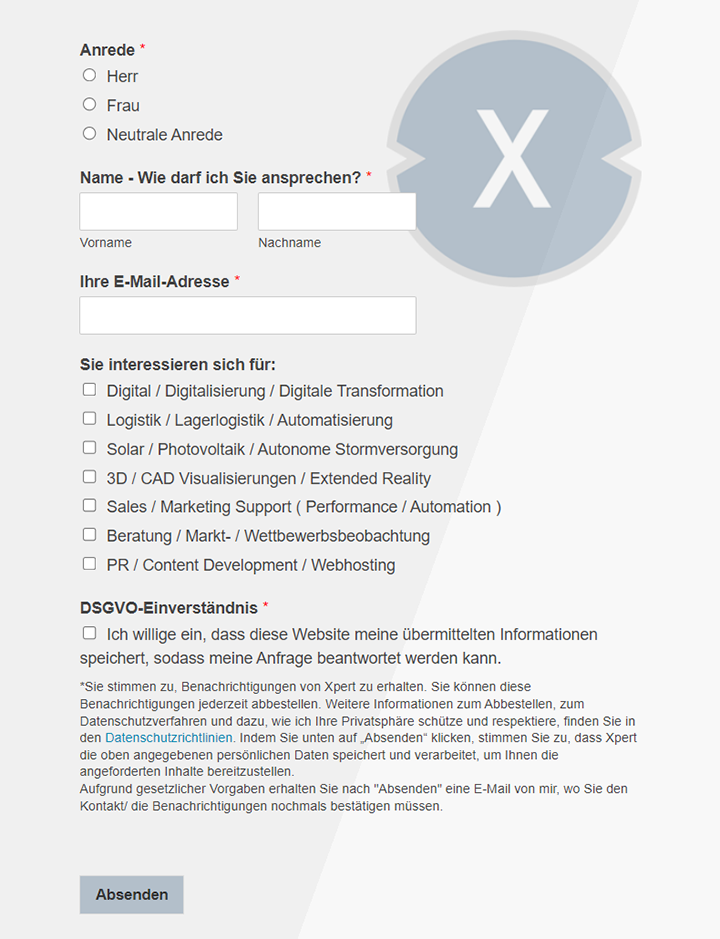The Economic Horseshoe: Global Challenges and Local Opportunities
Xpert pre-release
Language selection 📢
Published on: January 24, 2025 / update from: January 24, 2025 - Author: Konrad Wolfenstein

Economic horseshoe: If things become increasingly tight and difficult in the macrocosm of the economy, the markets in the local microcosm become more interesting again - Image: Xpert.Digital
Economic Horseshoe Explained: What Local Markets Can Learn from Global Uncertainties - Research
Interplay of markets: opportunities in the area of tension between global and local
In the area of tension between global and local economic markets, there is a remarkable dynamic, which can be referred to as “business horseshoes”. This metaphor describes how in times of global uncertainties and crises, the focus of many actors is more focused on local markets. There is an interesting interplay between the poles of the global macrocosm and the local microcosm of the economy. This text illuminates the underlying mechanisms, opportunities and challenges of this phenomenon and shows how companies and societies can benefit from this dynamic.
Global uncertainties as drivers of local strengths
The global economy is constantly faced with challenges that put its structure and functionality to the test:
- Crises and Disruptions: Trade conflicts, global pandemics, financial crises and geopolitical tensions are impacting international markets and leading to increased uncertainty.
- Dependencies and supply chains: Global logistics chains are susceptible to disruptions due to their complexity. Delivery bottlenecks and rising transport costs are driving companies to look for alternatives.
- Sustainability requirements: The pressure on companies to operate more sustainably is increasing. This often requires the integration of regional suppliers and resources.
These global challenges direct the focus of many players on local solutions. Here the “business horseshoe” becomes visible: the greater the problems at a global level, the more attractive local approaches appear.
Local markets: a microcosm full of potential
1. Resilience through regionality
Regional structures often prove to be more stable in times of crisis. Companies that rely on local suppliers can reduce dependencies on international logistics chains. This increases resilience and creates a more robust network.
2. Changing consumer behavior
Consumers are increasingly emphasizing transparency, sustainability and regionality. They prefer products made with local resources because they are perceived as high -quality and environmentally friendly. The growing “Buy Local” movement underlines this trend.
3. Flexibility and innovation
Local companies are often more agile than large, global corporations. You can react quickly to new market needs, experiment and develop innovative solutions. An example of this are small manufacturers that offer personalized products.
Advantages of local markets
The strengths of local markets can be clearly seen, especially in times of crisis:
- Shorter supply chains: Reliance on global transport routes is eliminated, which shortens delivery times and minimizes the risks of delays.
- Personal relationships: Local businesses benefit from closer customer relationships, which promotes trust and builds long-term loyalty.
- Strengthening the local economy: Commitment to local markets supports regional development and creates jobs.
Challenges of local markets
Despite all the advantages, local markets face a number of challenges:
- Limited economies of scale: Smaller production volumes often result in higher costs per unit, which can make local products more expensive.
- Competitive pressure: Local companies also compete with global players, especially in online retail. This competition makes it difficult for them to defend their market share.
- Limited resources: Local markets often have limited access to capital, skilled labor and technology.
Strategies for local companies in the “business horseshoe”
In order to survive successfully in this area of tension, local companies can apply targeted strategies:
1. Digitalization
The use of digital technologies is a key factor in the success of local businesses. Online platforms and digital marketing strategies can help increase reach and open up new customer segments.
2. Highlight local strengths
Local companies should focus on their unique quality characteristics such as freshness, regionality and sustainability. This can be achieved through targeted communication and branding.
3. Collaborations
By collaborating with other local companies, synergies can be exploited and shared resources can be used effectively. Networks and clusters help to increase competitiveness.
4. Sustainability initiatives
Sustainability is not only a competitive advantage, but also an important driver for long -term success. Local companies can position themselves through environmentally friendly production methods and social responsibility.
The “business hoof iron” as a symbol of a new balance
The image of the horseshoe illustrates the interaction between global and local markets. The two ends of the horseshoe represent the extremes of economic dynamics: the global end, which is often characterized by uncertainty and volatility, and the local end, stability and regionality. The bend of the horseshoe shows how these two poles are connected and influence each other.
In an increasingly networked world, it is crucial to find a balance between these two extremes. Companies that successfully combine both global and local strategies can achieve long -term competitive advantages.
Future perspectives: Local markets in a globalized world
The importance of local markets will continue to increase in the coming years. The drivers for this are:
- Technological progress: New technologies such as artificial intelligence and IoT also enable small companies to work more efficiently and compete with global actors.
- Sustainability as a priority: The transition to a circular economy and sustainable business models will strengthen local markets because regional resources play a central role.
- Changed consumer needs: The demand for authentic, transparent and regional products will continue to grow.
The concept of “business horseshoe” is an apt metaphor for observation that global uncertainties lead to an increased turn to local markets. This dynamic contains both opportunities and challenges. Companies that are able to use the strengths of local markets and at the same time think globally will be successful in the long term. The balance between global networking and local roots remains a central challenge for the economy of the future.
Our recommendation: 🌍 Limitless reach 🔗 Networked 🌐 Multilingual 💪 Strong sales: 💡 Authentic with strategy 🚀 Innovation meets 🧠 Intuition
At a time when a company's digital presence determines its success, the challenge is how to make this presence authentic, individual and far-reaching. Xpert.Digital offers an innovative solution that positions itself as an intersection between an industry hub, a blog and a brand ambassador. It combines the advantages of communication and sales channels in a single platform and enables publication in 18 different languages. The cooperation with partner portals and the possibility of publishing articles on Google News and a press distribution list with around 8,000 journalists and readers maximize the reach and visibility of the content. This represents an essential factor in external sales & marketing (SMarketing).
More about it here:
Between global chaos and local stability: what the business horseshoe teaches - background analysis
Global uncertainty, local strength: the return of regional economic cycles
The metaphor of the “economic horseshoe” describes an interesting dynamic in the global economy, which is particularly evident in times of uncertainty and global upheavals. It illustrates how attention and economic activity from the vastness, often confusing global markets are increasingly turning to the local, regional economic cycles. It is not a rigid theory, but rather an observing description that shows how the weights can shift in the economic structure when global structures stake.
The image of the horseshoe with its two ends, which are far apart, but still have a connection to each other, illustrates that the global and the restaurant are not isolated poles, but are in a constant interplay. If the global economic areas come under pressure, be it due to crises, trade conflicts or logistical challenges, companies and consumers are increasingly looking for stability and reliability in nearby, in the local. This withdrawal to the regional level can be seen as a kind of "economic gravity" that pulls the economic activity back to the roots when the global currents become turbulent.
Global storms, local anchor places: the shift in economic focus
When the global macrocosm of the economy gets out of balance due to disorders, crises or increasing complexity, new scope and opportunities for local markets are created. The supposed narrower of the microcosm then offers surprising advantages. This development is by no means a step backwards, but often a necessary adjustment based on a profound analysis of the risks and opportunities.
The return to regional supply chains
Global supply chains are susceptible to disorders. Long transport routes, political instabilities or natural disasters can paralyze entire production processes. In this context, local supply chains offer an alternative: they are often more resistant, more flexible and transparent. The proximity to suppliers and producers enables a faster reaction to unexpected events and reduces the dependence on complex international logistics networks. Companies are therefore increasingly looking for regional partners that they see as a reliable anchor in stormy times. This development not only strengthens the regional economy, but also shortens the transport routes, which has a positive effect on the environment.
Consumer preferences - more than just a trend
Consumers play a crucial role in this development. A growing awareness of the importance of sustainability, regionality and fair production conditions means that more and more people prefer local products and services. This changed consumption behavior is not just a short -term trend, but a profound social movement that is characterized by the desire for more transparency, authenticity and more conscious consumption. Trust in local producers and dealers is often higher than in anonymous, global corporations. The appreciation for craftsmanship and traditional production methods increases, which has a positive effect on the demand for regional products.
Strengthening the local economy as a social imperative
The promotion of the domestic economy is not only a question of self -benefit, but also a question of social responsibility. The support of local companies ensures jobs, promotes diversity and contributes to the development of living communities. In times when global inequality and social tensions increase, strengthening the local economy becomes an important instrument for social justice and economic stability. The local economy acts as a kind of buffer that can alleviate the effects of global turbulence and thus strengthens the resilience of entire regions.
The advantages of local markets in times of uncertainty
Local markets show their strengths in difficult times. They not only offer economic advantages, but also social and cultural values:
Agility and flexibility as a key to success
Smaller companies that act in local markets are often more flexible and agile than large corporations. You can react faster to changes, develop new products or adapt your services to the needs of customers. This adaptability is a crucial competitive advantage that enables you to be successful even in difficult times. The short decision -making channels and direct communication with customers are of great advantage.
Shorter ways, lower dependencies
Local markets reduce the dependence on global supply chains and logistics networks. This not only leads to lower transport costs, but also to more stability and security in the production processes. The short distances enable faster and more efficient processing of orders and reduce the risk of delivery delays or failures. This strengthens the competitiveness of local companies and ensures an advantage over global providers.
Personal relationships as capital
Local companies benefit from direct customer relationships. Personal contact, the establishment of trust and individual advice are decisive factors for success. Customers appreciate the proximity to the dealers, the opportunity to ask questions and get advice. This personal grade is a competitive advantage that global companies generally cannot offer. Personal relationships strengthen the binding of customers to local companies and promote loyal regular customers.
The challenges of the local market: obstacles on the way to success
Despite the many advantages that local markets offer, there are also challenges that may not be ignored:
Limited scale effects
A cost factor: Smaller production quantities in local markets can lead to higher production costs. Scale effects that large companies achieve through mass production are often difficult to achieve for smaller companies. This can affect competitiveness, especially compared to global actors who benefit from their size advantages. Local companies must therefore find innovative solutions to reduce their costs and at the same time maintain their quality and competitiveness.
The limited market
A challenge for growth: demand in local markets is naturally limited. This can limit the growth potential of the companies. In order to be successful, local companies therefore have to open up new markets and adapt their products and services to the needs of a wider customer class. The search for growth options is often a difficult balancing act in which the local roots must not be neglected.
Competitive pressure
Also in the local one factor: there is also competition in local markets, especially through global actors who act through online trading. This forces local companies to constantly adapt and improve their offers. Digitization is a crucial factor in order to keep up with the competition. It is important to use the strengths of the local market and at the same time open up the possibilities of the digital world.
Strategies for local companies: navigate in the business hoofing iron
In order to be successful in the context of the “business horseshoe”, local companies have to pursue innovative strategies:
The digital transformation
More than just one trend: digitization is not an optional extra, but a necessity for local companies. The use of digital tools, such as online shops, social media and digital marketing strategies, enables companies to increase their reach, attract new customers and improve their customer relationships. Digitization can also increase the efficiency of internal processes and thus increase competitiveness. The integration of digital technologies is not only a competitive advantage, but a prerequisite for survival in the modern economy.
Local strengths back in the foreground
Authenticity as a competitive advantage: Local companies should highlight their strengths such as quality, freshness, sustainability and regional connection. These values are of great importance for many customers and can be a crucial purchase criterion. The authenticity of the products and services, the personal touch and the proximity to customers are competitive advantages that are difficult to reach from global companies. The emphasis on one's own identity and regional roots creates trust and strengthens customer loyalty.
Cooperations: strong together
Cooperation with other local companies can lead to synergy effects and strengthen the regional economy. Common marketing campaigns, the exchange of know-how and the development of common products can increase the competitiveness of local companies. Cooperations create a network that bundles the strengths of the individual companies and thus enables a stronger position in the market. The merger of local companies is not only an economic advantage, but also a contribution to strengthening the community and regional cohesion.
The economic hoof iron: more than just a metaphor
The “business hoof iron” is more than just a metaphor, it is a description of a profound dynamic in the global economy. It shows that the relationship between the global and the local is not a static relationship, but a constant process of adaptation and change. The restaurant is not a retreat for economic losers, but an important pillar of a resistant and sustainable economy. In an increasingly networked world, the balance between global participation and local strength is a central challenge for companies and economies. The ability to react flexibly to changes, use the local strengths and to open up the opportunities of the digital world is crucial for success in this dynamic environment. The metaphor of the horseshoe reminds us that the economy is not a linear process, but a cyclical cycle in which the global and the restaurant are connected in a constant interplay. Understanding this dynamic is the key to successfully acting in a constantly changing world. The economic hoof iron therefore not only stands for economic observation, but also for an invitation to reflect on and actively shape your own role in this dynamic system.
The development described to the stronger emphasis on the local is not a departure from the global, but rather a necessary correction, a return to the basics of a resistant economy. It is about using the advantages of both levels and finding a balance that strengthens both global networking and local independence. The challenge is to use the opportunities of digitization and networking and at the same time to preserve the values and strengths of the local communities. In this sense, the business horseshoe is not only a description of the current economic situation, but also a call to design a more sustainable and fairer future.
We are there for you - advice - planning - implementation - project management
☑️ SME support in strategy, consulting, planning and implementation
☑️ Creation or realignment of the digital strategy and digitalization
☑️ Expansion and optimization of international sales processes
☑️ Global & Digital B2B trading platforms
☑️ Pioneer Business Development
I would be happy to serve as your personal advisor.
You can contact me by filling out the contact form below or simply call me on +49 89 89 674 804 (Munich) .
I'm looking forward to our joint project.
Xpert.Digital - Konrad Wolfenstein
Xpert.Digital is a hub for industry with a focus on digitalization, mechanical engineering, logistics/intralogistics and photovoltaics.
With our 360° business development solution, we support well-known companies from new business to after sales.
Market intelligence, smarketing, marketing automation, content development, PR, mail campaigns, personalized social media and lead nurturing are part of our digital tools.
You can find out more at: www.xpert.digital - www.xpert.solar - www.xpert.plus


























